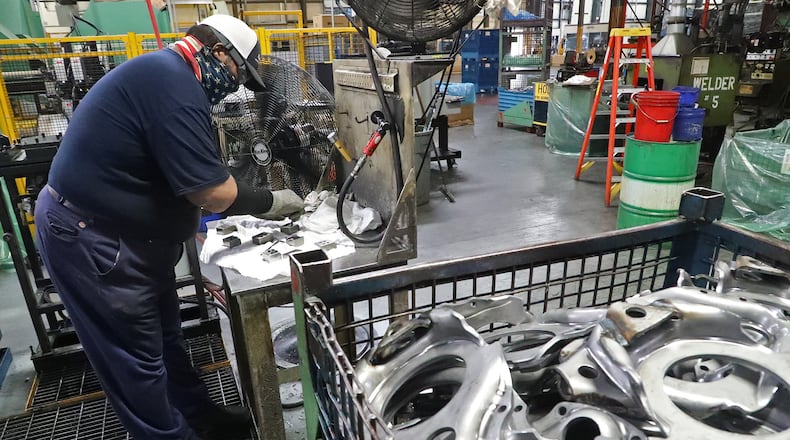The Midwest region had the slowest growth this decade at 3.1%. For comparison, the South grew about 10% and the West grew 9% since the last census.
Lee Hannah, an associate professor of political science at Wright State University, said population grow is slowing or declining across the Midwest.
People are more mobile now than they were years ago, Hannah said, so it is more common for someone to live further away from their hometown. Some people are simply moving to places for better weather and the amenities that come with that, Hannah said. Places like Arizona, Colorado and Idaho, which are known for their natural beauty and outdoor attractions, also saw marked jumps in their population.
Another reason for this slower growth in Ohio, he said, may be the shift in the U.S. from a manufacturing intensive economy to moving toward a finance, tourism, hospitality and technology intensive economy. Hannah said some of the faster growing states, like California, are attracting people moving there for the tech industry.
The population growth may be slowing because working-aged people are moving elsewhere for jobs, he said. Census data with more details, like age, will come out later this year.
Many manufacturing jobs have been outsourced to the South and overseas, taking many people who would have worked those jobs elsewhere. Ohio’s labor laws may also play a part in those jobs moving, Hannah said.
“Some people are moving just for the jobs,” Hannah said. “NCR moved to Atlanta, GM and other auto manufacturers are moving to Kentucky or South Carolina or Georgia.”
Also, some jobs just don’t exist like they did a few decades ago, like coal or mining jobs. Locally, manufacturing jobs at places like AK Steel in Middletown are fewer, too.
Other Rust Belt states, like West Virginia and Illinois saw population declines. West Virginia’s population declined by about 3% in the past decade.
The state and JobsOhio have been working in recent years to attract companies and workers to the state to try to solve that problem.
Spokesman Matt Englehart said JobsOhio has started an “Ohio is For Leaders” marketing campaign. The campaign includes billboards and digital marketing efforts.
JobsOhio and the state have been working to establish three innovation districts in Cincinnati, Cleveland and Columbus. These districts will merge the innovation and employment potential of research-oriented anchor institutions, high-growth firms, and tech and creative start-ups in well-designed, amenity-rich residential and commercial environments, Englehart said. The goal is to create 10,000 jobs over 10 years in each of the three Innovation District cities.
JobsOhio has also started a “Find Your Ohio” talent attraction program. The program is aimed at driving in-demand talent to Ohio by matching resumes with job opportunities at companies across the state. Since launch, JobsOhio has deployed a number of marketing initiatives to drive candidates from across the country to the site to submit their resumes, Englehart said.
The more localized Census data will give the state and JobsOhio a clearer picture, he said.
Suzanne Kunkel, executive director of the Scripps Gerontology Center and a sociology and gerontology professor at Miami University, said that Ohio is trending the way other Rust Belt states have.
“What’s going on in Ohio and a lot of other what I would call industrial or Rust Belt states is a slower rate of increase in the size of the population,” Kunkel said.
Three things affect the size of the population: how many people die, how many babies are born and migration, Kunkel said.
“Ohio has had some mostly net out-migration, so we’re losing people who are leaving the state, I think, often for better job prospects,” Kunkel said. “I think there are a lot of other states in our same category where the way the economy has been changing has made people move out.”
Kunkel said Ohio has an aging population because people who move away are typically working age and going elsewhere for a job. Those who stay tend to be older.
Ohio has the sixth largest number of older people in the U.S., Kunkel said. States that saw more growth in the past decade, like Utah and Texas, have younger populations, according to the Population Reference Bureau, a nonprofit organization that collects and uses statistics to inform people on population, health and the environment.
More detailed data on households’ racial, ethnic and gender makeup, whether they rent or own their homes, and how everybody is related in their homes, at geographic levels as small as neighborhoods, will be released sometime in August and September, the Census Bureau said.
The state with the largest gain in population was Utah with an 18% increase in population since the last census.
“I do think some of that is just cultural with LDS (The Church of Jesus Christ of Latter-day Saints) members having more children, but also the state is kind of a destination, especially for like outdoors recreation and everything like that,” Hannah said.
Kunkel said fertility rates and cultural differences can play a role in population growth.
Immigration likely also played a part in other states growing more than Ohio, Hannah said.
“Texas grew by 4 million people, at least some of that is probably people in the last 10 years who have immigrated from Mexico,” Hannah said. “The majority of immigration (to the U.S.) is from Mexico and Latin America, so that kind of explains why places like Houston are going to be a bigger magnet for that (than the Midwest) for a lot of realistic reasons.”
Redistricting data
Ohio’s slow population growth will cause the state to lose one U.S. House of Representatives seat, going from 16 to 15. Ohio is among six states that will lose Congressional seats.
Fifteen seats is the fewest seats Ohio has ever had in U.S. history. In 1910, the furthest back the Census data goes back, Ohio had 22 representatives in the U.S. House. In the 1930s and 1960s, Ohio had 24 representatives.
From 1960 to 2020, New York lost 15 seats, Pennsylvania 10 seats, Ohio nine seats, Michigan six seats and Illinois seven seats. In that same period, Hannah said, Texas has gained 15 seats in the U.S. House, California has gained 14 seats and Florida is up 16 seats in the House from what the state had in 1960.
“It’s relative,” Hannah said. “Ohio is still growing, but not keeping up with the rest of the country..”
Redistricting data won’t be ready until months past the original March 31 deadline because of the pandemic and the discovery of anomalies the Census Bureau needed to iron out, the AP reported.
Twenty-seven states are required to finish redistricting this year, including Ohio. States with tight deadlines this year have gone to court to extend them, changed deadlines through constitutional amendments and talked about using other data sources. Ohio and Alabama have sued the Census Bureau, trying to force the agency to release the redistricting data sooner.
About the Author



